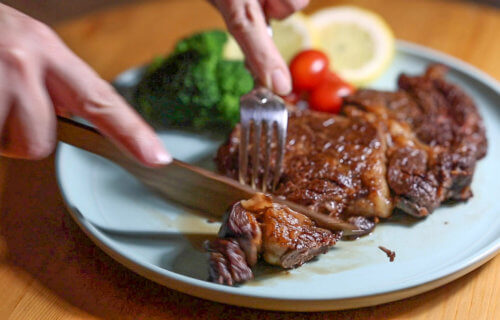
COLLEGE PARK, Md. — A new type of knife carved from wood may forever change how people cut their food at the dinner table. Through a new hardening process, researchers from the University of Maryland say this wooden utensil is actually 23 times harder than normal and three times sharper than the ordinary stainless steel dinner knife. The result is a sustainable piece of cutlery that goes through steak like butter.
Today, the sharpest knives on the market are either steel or ceramic, both man-made materials. Manufacturers must forge these items in a furnace under extreme temperatures. Now, however, study authors have come up with an alternative by making wood as hard as steel without the astronomically high heat.
“The knife cuts through a medium-well done steak easily, with similar performance to a dinner table knife,” senior author Professor Teng Li says in a statement. “Afterwards, the hardened wood knife can be washed and reused, making it a promising alternative to steel, ceramic, and disposable plastic knives.”
While wood processing techniques like steaming or compression have been around for centuries, they have not been able to produce products as strong as their steel or ceramic counterparts.
“When you look around at the hard materials you use in your daily life, you see many of them are man-made materials because natural materials won’t necessarily satisfy what we need,” Prof. Li adds. “Cellulose, the main component of wood, has a higher ratio of strength to density than most engineered materials, like ceramics, metals, and polymers, but our existing usage of wood barely touches its full potential.”
Toughening up wood from the inside
Since only 40 to 50 percent of wood products contain cellulose — a plant fiber — with the rest consisting of binders like hemicellulose and lignin, its strength falls short of man-made materials. To remedy this, the researchers developed a technique to remove the wood’s weaker components without damaging the cellulose skeleton.
“It’s a two-step process,” Prof. Li says. “In the first step, we partially delignify wood. Typically, wood is very rigid, but after removal of the lignin, it becomes soft, flexible, and somewhat squishy. In the second step, we do a hot press by applying pressure and heat to the chemically processed wood to densify and remove the water.”
Researchers have developed a knife made of hardened wood that is 3x sharper than a dinner table knife. This cutlery is a promising alternative to knives made of steel, ceramic, and disposable plastic. Read more in @Matter_CP: https://t.co/HXew7JYgAm@ToLiTeng pic.twitter.com/PoCqEB8AXE
— Cell Press (@CellPressNews) October 20, 2021
After carving the material into the desired shape, the team coated it with a mineral oil. This preserves the knife’s sharpness during use or when users wash it afterwards. The researchers examined their creation under a microscope to determine the source of its strength.
“The strength of a piece of material is very sensitive to the size and density of defects, like voids, channels, or pits,” Prof. Li explains. “The two-step process we are using to process the natural wood significantly reduces or removes the defects in natural wood, so those channels to transport water or other nutrients in the tree are almost gone.”
Study authors also showed that this process can also produce wooden nails which are as sharp as conventional steel ones but have the added benefit of being rust resistant. The team demonstrated that they could hammer them through three stacked boards without any damage to the nails.
More eco-friendly kitchenware?
The process could also potentially be more environmentally-friendly than manufacturing other man-made materials. For example, the first step requires boiling the wood in a bath of chemicals to 100 degrees Celsius, whereas the process to make ceramics requires heating materials to a few thousands degrees. Researchers add that they can then re-use the chemicals to make another batch of ultra-hard wood to help minimize waste.
“In our kitchen, we have many wood pieces that we use for a very long time, like a cutting board, chopsticks, or a rolling pin,” Prof. Li concludes. “These knives, too, can be used many times if you resurface them, sharpen them, and perform the same regular upkeep.”
The findings appear in the journal Matter.
South West News Service writer Tom Campbell contributed to this report.
